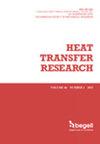温度梯度和流体振动对旋转圆筒中热毛细管液滴行为的影响
IF 1.6
4区 工程技术
Q3 THERMODYNAMICS
引用次数: 0
摘要
当流体从表面张力较低的区域流向表面张力较高的区域时,其气泡或液滴会沿着温度梯度(∇T)的方向移动,这一过程被称为马兰戈尼流。本文采用计算流体动力学(CFD)方法,对旋转圆筒中停滞和振动液体的液滴运动进行了分析和数值计算。对于两相流,使用商业程序 Ansys-Fluent 对支配连续守恒方程进行求解。流体体积 (VOF) 方法被认为是研究多相相互作用的有用研究工具。它在二维和三维域中跟踪液体/液体界面。随着马兰戈尼数的增加,液滴的固有速度降低,这与文献中记载的早期太空搭载实验结果一致。这项工作揭示了液滴在零重力下的复杂行为,其中一些被忽视的力,如旋转运动和主流体振动,在重力存在时消失,是观察到的行为的主要来源。研究发现,热毛细管液滴迁移在重力作用下并不明显,但受到小频率振幅(Am)的显著影响,随着振幅的增大而减小。研究还表明,在旋转圆筒内的静态液体中,热毛细管液滴迁移速度降低。温度梯度(∇T)的增加也会增加液滴在振动流体和不同马兰戈尼数(Ma)的旋转圆筒内的迁移速度。本文章由计算机程序翻译,如有差异,请以英文原文为准。
Influence of Temperature Gradients and Fluid Vibrations on the Thermocapillary Droplet Behavior in a Rotating Cylinder
When a fluid moves from lower to higher surface tension regions, its bubble or droplet moves in the direction of the temperature gradient (∇T), a process known as Marangoni flow occurs. In this paper, the drop movement in both stagnant and vibrated liquid in a rotating cylinder is analyzed and numerically presented using a computational fluid dynamics (CFD) approach. For two-phase flow, the governing continuum conservation equations are solved using the commercial program Ansys-Fluent. The Volume of Fluid (VOF) method has been found to be a useful research tool for studying multiphase interaction. It tracks the liquid/liquid interface in 2D and 3D domains. As the Marangoni number increases, the inherent velocity of drops decreases, which is consistent with earlier space onboard experimental findings that have been documented in the literature. This work revealed the complex behavior of droplets in zero gravity, where some neglected forces, such as rotational motion and host fluid vibration, that vanish in the presence of gravity, are the main source of the observed behavior. It was discovered that the thermocapillary droplet migration, which was insignificant in the presence of gravity, was significantly influenced by the small frequency amplitude (Am), which decreases with an increase in it. The study also showed that, in a static liquid inside a rotating cylinder, the velocity of thermocapillary droplet migration decreased. Up until this effect vanishes with increasing temperature gradient, increasing the temperature gradient (∇T) also increases the migration speed of the droplet inside the vibrating fluid and a rotating cylinder of different number of Marangoni (Ma
求助全文
通过发布文献求助,成功后即可免费获取论文全文。
去求助
来源期刊

Heat Transfer Research
工程技术-热力学
CiteScore
3.10
自引率
23.50%
发文量
102
审稿时长
13.2 months
期刊介绍:
Heat Transfer Research (ISSN1064-2285) presents archived theoretical, applied, and experimental papers selected globally. Selected papers from technical conference proceedings and academic laboratory reports are also published. Papers are selected and reviewed by a group of expert associate editors, guided by a distinguished advisory board, and represent the best of current work in the field. Heat Transfer Research is published under an exclusive license to Begell House, Inc., in full compliance with the International Copyright Convention. Subjects covered in Heat Transfer Research encompass the entire field of heat transfer and relevant areas of fluid dynamics, including conduction, convection and radiation, phase change phenomena including boiling and solidification, heat exchanger design and testing, heat transfer in nuclear reactors, mass transfer, geothermal heat recovery, multi-scale heat transfer, heat and mass transfer in alternative energy systems, and thermophysical properties of materials.
 求助内容:
求助内容: 应助结果提醒方式:
应助结果提醒方式:


